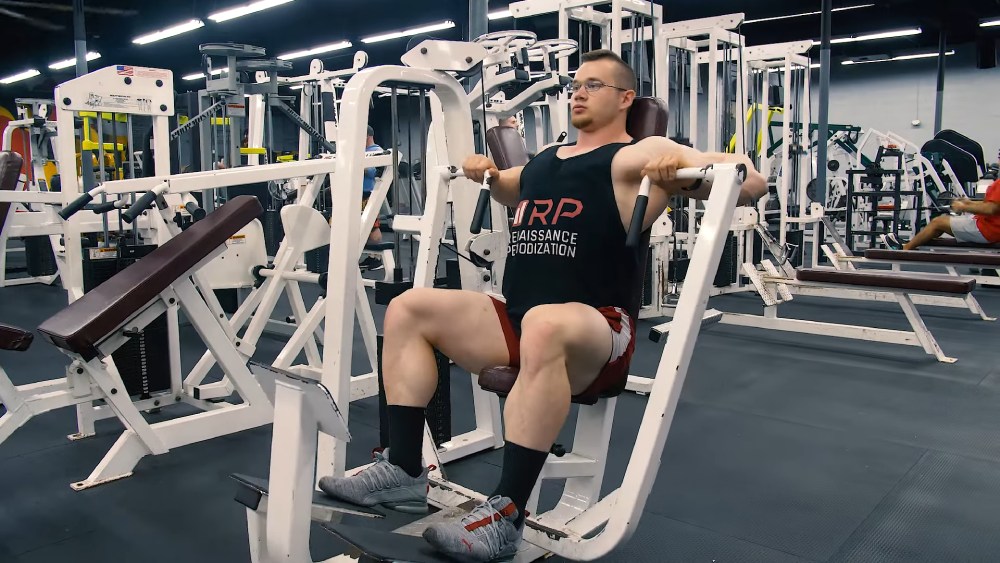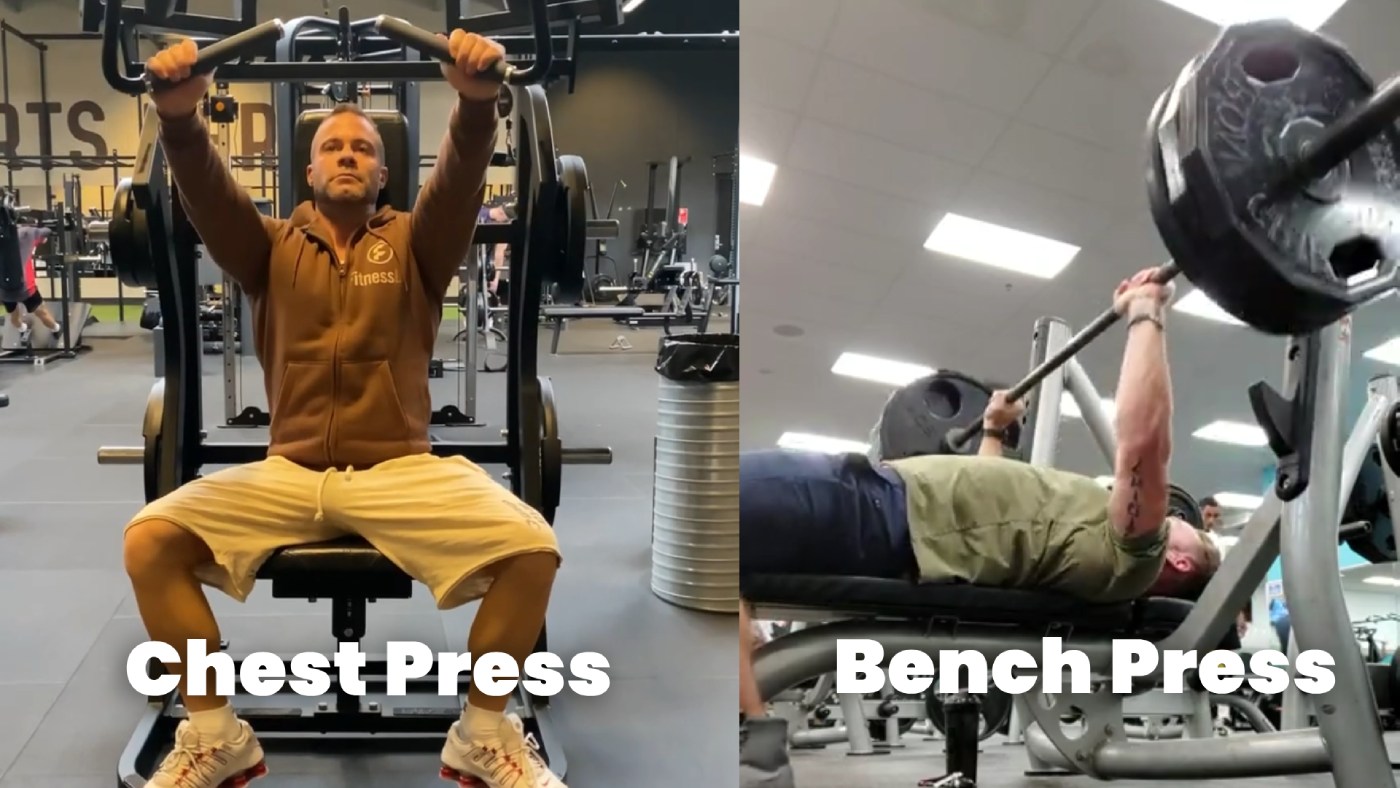Are you torn between the chest press and the bench press for your workouts? Let’s compare the 2 exercises.
Learn why the chest press might be your go-to for safety and targeted muscle growth, or why the bench press could be the key to overall strength and symmetry. This guide cuts through the complexity, equipping you with the knowledge to make the best choice for your fitness journey.
Jump to:
Understanding Chest Press and Bench Press
Chest Press

The chest press, when performed on a chest press machine, is a focused and controlled exercise targeting the pectoral muscles.
Situated on the machine, you’re positioned with a backrest supporting your spine, ensuring proper posture. In front of you are the handles, which you’ll push directly away from your body. As you engage in this motion, the pectoral muscles are activated, along with secondary involvement of the triceps and deltoids.
The machine’s structured design aids in maintaining correct form, minimizing the risk of injury. This isolation of the chest muscles makes it an effective exercise for developing chest strength and size.
The chest press machine is also beneficial for those new to weightlifting, offering a guided and safe way to build upper body strength.
Chest Press Pros
Ease of Learning and Setup
The chest press, especially on a machine, stands out for its straightforward learning curve. Unlike the bench press, which demands a nuanced grasp of barbell mechanics, the chest press machine offers a clear and uncomplicated setup. Step in, adjust the seat, select your weight, and you’re ready to go. This simplicity is a boon for beginners and a time-saver for all.
Shoulder Safety and Reduced Injury Risk
Shoulder health is paramount in any upper body workout. The chest press machine, with its fixed movement path, significantly reduces the risk of shoulder injuries. Unlike free weights, where stabilizing the weight can strain the shoulder joints, the machine guides your motion. This controlled environment means safer workouts, especially for those with pre-existing shoulder issues or those working towards rehabilitation.
Superior Isolation of Chest Muscles
Targeting specific muscle groups can be a complex task. The chest press machine excels at isolating the pectorals. By minimizing the involvement of secondary muscles, it ensures the chest muscles do the heavy lifting. This isolation is critical for focused muscle development and for those aiming to correct muscular imbalances.
Controlled Muscle Targeting and Consistent Resistance
One of the unsung benefits of the chest press machine is the ability to provide consistent resistance throughout the exercise. This steady tension is a key factor in muscle growth and endurance building. Additionally, it allows for precise targeting of different parts of the chest, depending on the machine’s settings and your posture.
Independence: No Spotter Required
The need for a spotter is often a hurdle in exercises like the bench press, especially when pushing your limits. The chest press machine eliminates this need. It empowers you to train independently, without relying on a gym partner. This autonomy not only enhances safety by preventing over-lifting but also adds a layer of confidence as you manage your own workout intensity.
Chest Press Cons
Constrained Range of Motion
When we talk about the chest press, especially the machine variant, one notable limitation is its restricted range of motion. Unlike the bench press, where you can move the barbell freely in a natural arc, the machine dictates a fixed path. This confinement can limit the full stretch and contraction of the chest muscles, potentially impacting the depth of muscle development. For those seeking a comprehensive chest workout, this constraint is a significant consideration.
One Size Doesn’t Fit All
Gym equipment is often designed with a ‘one-size-fits-all’ approach, but the reality can be quite different. The chest press machine is no exception. Users with varying body types and limb lengths might find it challenging to adjust the machine for optimal fit and effectiveness. This mismatch can lead to awkward postures during exercise, potentially reducing the exercise’s efficacy and increasing the risk of strain.
Less Emphasis on Stabilization and Functional Strength
While the chest press machine is excellent for isolating the pectoral muscles, it falls short in engaging the stabilizing muscles. In a real-world scenario, strength isn’t just about muscle size; it’s about how effectively you can control and maneuver your body and external objects. The bench press, involving free weights, requires and thus develops stabilization and functional strength. The chest press machine, by providing support and a guided motion, doesn’t challenge these auxiliary muscles to the same extent. This lack of engagement can be a drawback for athletes and fitness enthusiasts who prioritize overall functional strength.
Bench Press

The bench press is a fundamental weightlifting exercise performed using a barbell and a flat bench.
It begins with you lying on your back on the bench, gripping the barbell with hands just wider than shoulder-width apart. As you lower the barbell to your chest, your pectoral muscles are engaged in a compound movement. Then, pressing the barbell back up to the starting position involves the triceps and shoulders.
This exercise is not just about chest development; it’s a comprehensive upper body workout that also targets the anterior deltoids and the triceps. The bench press is highly regarded for its effectiveness in building upper body strength and muscle mass.
It’s a staple in many strength training and bodybuilding programs due to its ability to work multiple muscle groups simultaneously.
Bench Press Pros
Maximized Range of Motion and Muscle Engagement
Delving into the bench press, we uncover its superior capability to train a broader range of muscles. Its full range of motion allows for a more extensive muscle stretch and contraction, particularly vital for pectoral development. This comprehensive movement not only targets the chest but also engages the shoulders and triceps more effectively. It’s a holistic approach that mimics natural movement patterns, making it a cornerstone for those striving for a well-rounded upper body workout.
Enhanced Stabilization Muscle Training
A key advantage of the bench press lies in its demand on stabilization muscles. As you maneuver the barbell, your body activates numerous small muscles to maintain balance and control. This engagement builds functional strength – the kind that’s essential not just in the gym, but in everyday life. It’s about cultivating a body that’s strong and adept, capable of handling real-world physical challenges with ease.
Established Effectiveness in Strength Training
The bench press is not just another exercise; it’s a proven, time-tested component in strength training. Revered in both CrossFit and traditional bodybuilding circles, its effectiveness in building upper body strength is undisputed. It’s a benchmark (pun intended) for measuring progress and strength, making it a staple in any serious strength training regimen.
Promotion of Symmetrical Strength Development
Symmetry in strength is crucial, and the bench press addresses this beautifully. It encourages an even distribution of effort across both sides of your body, preventing muscle imbalances. This aspect is particularly beneficial for athletes and fitness enthusiasts keen on maintaining a balanced physique and functional strength.
Alignment with Everyday Movement Patterns
Lastly, the bench press shines in its ability to mimic everyday movements. Think about pushing a heavy door or shoving a piece of furniture; these actions resemble the bench press motion. By training in a way that mirrors real-life activities, you’re not just building muscles, you’re enhancing your capability to tackle daily tasks with greater ease and efficiency.
Bench Press Cons
Demands Higher Technical Skill
The bench press, while a cornerstone in strength training, isn’t a walk in the park. Its execution requires a more nuanced understanding of technique. From gripping the barbell correctly to maintaining proper form throughout the movement, each aspect demands precision. This complexity can be a hurdle for beginners, who must invest time and effort to master these skills. For those new to lifting, the learning curve here is steeper compared to simpler, more intuitive exercises like the chest press.
Increased Injury Risk and Spotter Necessity
With greater power comes greater responsibility, and in the case of the bench press, a heightened risk of injury. The involvement of heavy weights and a free-range motion raises the stakes. Improper form or overexertion can lead to strains or, worse, serious injuries, particularly in the shoulder and pectoral regions. This risk underscores the importance of having a spotter, especially when lifting heavy or pushing your limits. The spotter’s role is crucial not just for safety but also for providing mental reassurance, allowing you to focus fully on your performance.
Potential for Overtraining and Muscle Imbalances
The bench press, if not integrated thoughtfully into a well-rounded workout routine, can lead to overtraining of certain muscle groups. Its intense focus on the chest, shoulders, and arms may overshadow other areas, potentially creating muscular imbalances. It’s essential to balance bench press sessions with exercises that target the back, legs, and core to maintain a harmonious physical development. Overtraining can also be a concern, as the allure of quick gains might tempt enthusiasts to overdo this exercise, leading to fatigue and diminishing returns in muscle growth and strength.
Who Should Do Chest Press & Bench Press
Chest Press for Beginners
If you are new to strength training or just getting started with building muscle at the gym, the machine chest press is an excellent choice for you. This exercise helps you target your chest muscles, as well as your deltoids and triceps, while providing the support and stability necessary for a beginner. Some advantages of the machine chest press include:
- Safety: The fixed movement path of the machine reduces the risk of injury.
- Ease of use: Quick adjustments on the machine cater to your desired weight or seat position.
- Isolation: Focuses primarily on your chest muscles, aiding in their development.
As you progress in your fitness journey, incorporating free weights can lead to increased strength and muscle growth. However, ensure that you thoroughly understand proper form and technique before moving on to more advanced exercises.
Bench Press for Experienced Lifters
For those experienced in strength training and comfortable with gym equipment, the barbell bench press can offer superior benefits to help take your muscle-building endeavor to the next level. Providing a more challenging and engaging workout, the bench press stimulates a wider range of muscles when compared to the chest press machine. Here are some key benefits you can experience while performing barbell bench presses:
- Versatility: Multiple grip options allow targeting different muscle groups and incorporating various techniques.
- Compound movement: Engages multiple muscle groups, including chest, triceps, shoulders, and core.
- Greater potential for progression: Allows incremental weight increases to continually challenge your strength.
Remember that proper form is crucial when performing the bench press to prevent possible injuries. If you are unsure about your technique, do not hesitate to seek guidance from a personal trainer or other experienced gym-goers.
By understanding your current fitness level, you can make appropriate choices to tailor your workout regimen and effectively build strength in your chest and supporting muscle groups.
Variations and Alternatives to Chest Press and Bench Press
Chest Press Machine Variations
Adjustable Seat and Handle Positions
One of the key features of chest press machines is the adjustable seat and handle positions. This versatility allows users of varying heights and arm lengths to find the most comfortable and effective setup for their workout. By adjusting the seat height, you can ensure that your arms are at the correct angle for maximum chest engagement. Similarly, handle adjustments can accommodate different arm lengths, ensuring a full range of motion and effective muscle targeting.
Incline, Decline, and Flat Chest Press Options

Chest press machines often come with options for incline, decline, and flat settings, each targeting different areas of the chest. The incline chest press focuses on the upper pectorals, a key area for building a well-rounded chest. Decline variations shift the emphasis to the lower pectorals, often a neglected area in chest workouts. The flat chest press provides a balanced workout across the entire chest. Incorporating all these variations into your routine can lead to more comprehensive chest development.
Variable Resistance Mechanisms
Many chest press machines offer different resistance mechanisms, such as plate-loaded, pin-selected weight stacks, or even resistance bands. Each type provides a unique resistance feel, with plate-loaded and weight stack machines offering a more traditional weightlifting experience. Resistance band machines, on the other hand, can provide a different tension curve, which can be beneficial for muscle growth and joint health.
Unilateral and Bilateral Movement Options
Some chest press machines are equipped with the capability for unilateral (single-arm) or bilateral (both arms) movements. Unilateral exercises are excellent for addressing muscle imbalances and focusing on individual muscle group strength. Bilateral movements, being more traditional, allow for heavier lifting and overall chest development.
Incorporating Different Grips

Lastly, varying your grip on the chest press machine can significantly alter the muscles being worked. Most machines have handles that allow for a standard grip, a neutral (palms facing each other) grip, and sometimes even a reverse grip. Experimenting with these grips can help target different parts of your chest and triceps, adding diversity to your chest workouts and preventing plateaus.
Bench Press Variations
Traditional Flat Bench Press
At the core of bench press variations is the traditional flat bench press. This staple exercise focuses on the overall development of the pectoral muscles, along with the triceps and front deltoids. It’s a go-to move for anyone looking to build a strong, balanced chest. The flat bench press remains a benchmark (no pun intended) for assessing upper body strength.
Incline and Decline Bench Press

Branching out from the flat bench, we have the incline and decline variations. The incline bench press shifts the focus towards the upper chest and shoulders, providing a comprehensive approach to chest development. It’s crucial for sculpting that upper pectoral area which can sometimes be neglected. On the flip side, the decline bench press emphasizes the lower chest muscles, offering a complete pectoral workout when combined with the other variations.
Close-Grip Bench Press
Targeting the triceps more intensely, the close-grip bench press is a variant where your hands are positioned closer together on the bar. This shift not only intensifies the work on your triceps but also engages the inner chest muscles. It’s a fantastic variation for those looking to enhance arm strength and definition, while still working the chest.
Wide-Grip Bench Press
Conversely, the wide-grip bench press focuses more on the outer chest and reduces the strain on the triceps. By gripping the bar wider than shoulder width, you can isolate the pectoral muscles more effectively. This variation is excellent for building a broader chest.
Paused Bench Press
Adding a pause at the bottom of the bench press (where the bar is just above the chest) can drastically change the exercise dynamics. This technique, known as the paused bench press, increases time under tension and helps develop explosive power. It’s a favorite among powerlifters for its ability to improve the ‘sticking point’ in the bench press.














